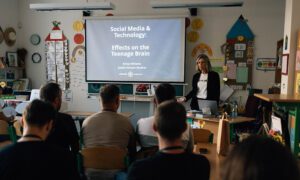October 19, 2023
Social Media and the Teenage Brain
By now, most adults recognize that a new generation has emerged with smartphones in hand and social media on the mind. This is the i-Generation, also known as Gen Z––those born between 1996-2000 and 2010, and with Generation Alpha right behind them. At the same time, western culture was giving birth to AOL Instant Messenger in 1997, Facebook starting on college campuses in 2004, Apple’s iPhone release in 2007, and the “like button” invented in 2009. This all culminated with Facebook’s history-changing IPO, and the purchase of Instagram, and its already-emerging selfie-culture in 2012.
2012 is a key date for understanding what social scientists consider the beginning of the demise of the state of youth mental health across both the US and Europe. Research on percentages of the reported incidents of teen depression, self-harm, psychological stress, and suicide began skyrocketing in 2012, and the graphs continue increasing “up and to the right.” One decade later, we are faced with a generation that is more distracted, distraught, lonely, anxious, and struggling to put their devices down for even a few minutes. People addicted to social media live their lives online, 24-7, in front of thousands of people every single day, never getting a break from themselves, their followers, or their phones.

Most adults recognize that being a teenager and a young adult comes with its biological and relational challenges, released with the onset of puberty and ongoing past the adolescent years into ages 20-25. The study of brain development gives real physiological reasons why these years are difficult. The brain is actually not fully developed until age 25, which is past most people’s university graduation. The last brain tissues to develop and neuropathways to connect are in the front lobe of the brain. It’s called the prefrontal cortex, and this is the portion of the brain that every youth leader, teacher, and parent should know about!
Executive functions of the brain reside in this prefrontal cortex, including personality formation, planning and organization skills, demonstrating responsibility and following through, showing judgment, objectivity, self-awareness, and wise decision-making. This also includes exercising emotional stability, impulse control, and resisting temptation, which are all under-developed and under construction in the adolescent brain. This does not mean that teens cannot execute these functions––it just means that fewer neuropathways exist in the underdeveloped location, so it takes the brain longer to access these skills. And let’s be honest; the desire or intention to make a good choice can get hijacked along the neuropathway when coming face-to-face with hormone surges, the emotional center of the brain, heightened cortisol stress levels, and innate teen curiosity, which are all at war within a young person’s body. This biological knowledge of adolescents should cause us to display compassion and grace to our young people, who are experiencing a lot of tumult and do not even realize it.

But what does this brain development have to do with social media? Well, the second neurological aspect that every youth leader, teacher, and parent should know about is how addiction works. Addiction is actually a form of learning, where an input enters the body through one of the five senses and creates a neurological pathway along which information can travel, thus producing learning and memory and forming habits. However, certain inputs (such as narcotics and alcohol) cause the brain pathways to strengthen, and the reward center of the brain, the dopamine receptors, gives off serious pleasure feelings that leave people wanting to repeat the input.
While addictive dopamine hits can come from long-considered dangerous substances like heroin or hard alcohol, other inputs, such as sugar, pornography, video games, and social media apps, are also doing the same thing. Nevertheless, with technology, the dopamine hits are at a micro-level. You see, unfortunately, the technology we use is not as neutral as it seems. Persuasive technology is when a device or app is created with notifications and functions that cause the user to repeat actions, giving off micro-sized dopamine hits that leave the young person wanting more. More likes. More messages. More views. More posts. More scrolls. More potential social currency. And more compulsive behaviors from which big businesses are making money hand over fist. Consequently studies are showing that after only two hours on social media, users begin to show more depressive tendencies and a decrease in social skills and life skills because of the inability to put the phone down and engage the brain in other activities, These includes: in-person connection, being active outdoors, learning, and developing other hobbies.

As a youth leader training organization, we in Josiah Venture are concerned about this addiction as it gains prevalence across Europe. If we as adults struggle to discipline ourselves with our screen time and social media scrolling, how much harder is it for a young person who lacks some of the strength to resist its temptations and dangers? We believe that teenagers and their brains are fearfully and wonderfully made by God, even in spite of our fallen world. We believe that God gives wisdom freely to all who are willing to engage in this battle for the minds and bodies of teenagers in our midst. We believe that God has given us stewardship over the next generation, to love them and lead them well, which means that digital wellness in the form of discipline and boundaries with technology must be a part of our engagement with young people. The god of this age has blinded the minds of unbelievers and wants young people to live in the world’s chaos and anxiety. May we take a stand against the devil’s schemes, particularly in the area of social media and tech devices. May we begin frequent dialogue with teens about what draws them into technology, what they value, and where they get their worth. Ultimately, may we shepherd this generation toward God’s green pastures and still waters, where they can get their value and identity from Christ, are free from all types of addictions, and can say with confidence, “The Lord is my Shepherd; I lack nothing.”





